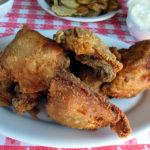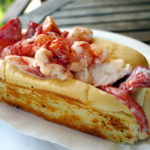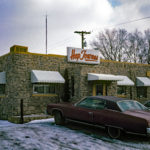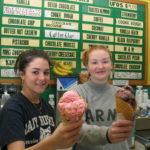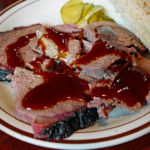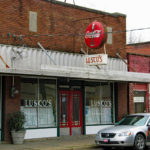Yankee Doughnut Dandies
In New England, doughnuts are an art. We needn't argue their humble virtues in contrast to such upwardly mobile pastries as scones and croissants or the meretricious muffins that pass for breakfast nowadays. Nor is it necessary to enumerate the ways in which a well-crafted doughnut belongs to a different food group than the greasy sinkers sold by franchised shops (including the incomprehensibly over-praised Krispy Kreme—cloying and dwarfish, leaden not long after being cooked, and about as interesting as a brick of sucrose). We've sampled a veritable mountain of doughnuts from all over the country, and Yankee superiority is our inevitable conclusion. A visit to four of the region's hallowed doughnut shops, where the proof is in the eating, is all the evidence anyone needs.
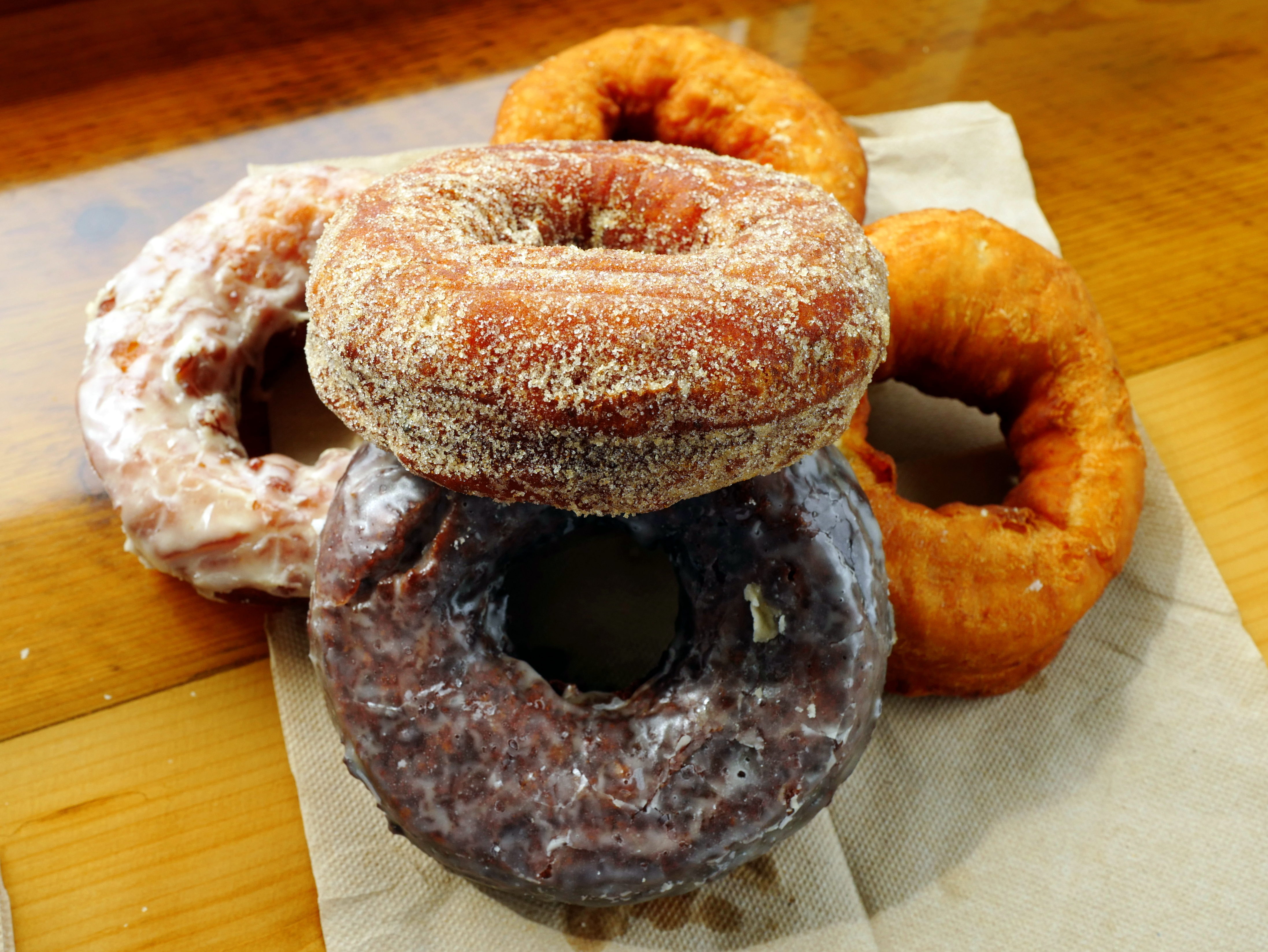
By Jane and Michael Stern
Originally Published 2000 Gourmet Magazine
In New England, doughnuts are an art. We needn’t argue their humble virtues in contrast to such upwardly mobile pastries as scones and croissants or the meretricious muffins that pass for breakfast nowadays. Nor is it necessary to enumerate the ways in which a well-crafted doughnut belongs to a different food group than the greasy sinkers sold by franchised shops (including the incomprehensibly over-praised Krispy Kreme—cloying and dwarfish, leaden not long after being cooked, and about as interesting as a brick of sucrose). We’ve sampled a veritable mountain of doughnuts from all over the country, and Yankee superiority is our inevitable conclusion. A visit to four of the region’s hallowed doughnut shops, where the proof is in the eating, is all the evidence anyone needs.
“People like doughnuts because they are honest,” says Alex Kogler, who is revered among connoisseurs for the powdered-sugar-dusted, cream-filled doughnuts he makes at BUTLER’S COLONIAL DONUT HOUSE, in Westport, Massachusetts.
“They did become unpopular some years back,” says Chris Kogler, Alex’s wife, as she pours a cup of coffee in their diminutive bakery on the old road to Horseneck Beach. “For a while there, croissants, then bagels, were all anyone talked about,” she continues. “Now doughnuts are back. And why not? For the person who needs a treat, a doughnut is the answer, the only real answer in the morning. There are some who have asked if we will ever make a diet doughnut. And to them I say, ‘Why? What is the matter with you? Are you so darn sick that you cannot enjoy yourself, just one doughnut’s worth?’ ”
If you are going to have only a single doughnut—what a strange, sad thought!—one from Butler’s would be an excellent choice, for these are not coffee companions, meant for dunking. They are more like giant, featherweight cream puffs, holeless, sliced in half, and filled with whipped, sweetened cream (plain or mocha-flavored). Made from raised yeast dough, they are so frail that you want to hold them very gently, lest you dent the surface with a heavy thumb. The cool, silky filling is pure and white—or in the case of mocha, tan—and the counterpoise of ethereal cake, crowned by a spill of powdered sugar, is angelic. Alex also creates a majestic Long John, for which the same dough is fashioned into a rectangular shape, fried, then cut in half and filled with whipped cream and a thin ribbon of black raspberry jelly. The sweetness of the jelly tilts the flavor balance of this stout little hero toward delirious. As Alex likes to put it, his Long John is “the ultimate.”
To make such heavenly edibles demands major muscle power. A former professional hockey player, Alex laments that he can turn out no more than 35 dozen per hour; he has to do everything by hand to ensure that the dough has the proper texture and that the whipped cream is impeccable. When we ask if he ever considered buying a doughnut machine, he holds up his two incredibly beefy forearms: “Here, this is my machine!”
The Koglers have been selling doughnuts since 1979, when they bought the shop from Bill and Jeanette Butler, who opened the bakery in a shack in front of their house in 1955. The Koglers expanded the premises slightly, although there is still barely any place to sit, and they added mocha filling and Long Johns to the Butlers’ repertoire (which also includes an assortment of non-filled doughnuts). Hours of operation are severely limited. The famous cream doughnuts are not even made in the summer, when the fragile filling would wilt in the heat; and in winter the bakery is open only Thursday through Sunday. If all the doughnuts are sold before closing time (which often happens, as when chef George Germon of Providence’s estimable Al Forno buys dozens as a treat for his staff), the door is locked and Alex goes home so he can get some rest and, if it’s a work night, return to the bakery around 11 P.M., when a new day’s batch is begun.
Walter “Bud” Drescher is another former athlete—high school football, semi pro hockey—whose brute strength is applied to the creation of beautiful doughnuts. Starting sometimes as early as 1:30 A.M. in the busy summer months, he is able to make up to 600 dozen in a long morning at the always-bustling shop called ALLIE’S, in North Kingstown, Rhode Island. Son-in-law of Allie Briggs, who started the business in 1968, Drescher moves around his kitchen like a contestant in the World’s Strongest Man competition, carrying mighty sacks of flour and broad bowls full of batter, moving vast pans of pastry in and out of ovens, twisting twists and cutting “stix” with hands that fly at lightning speed. “This keeps me pumped,” he says as he kneads 50 pounds of dough destined to become “cinnamon stix.” “It’s like doing 500 to a thousand push-ups every day.”
Allie’s is so popular that it has three doors, allowing three to four lines of people to wait at the counter to place take-out orders for honey-dipped doughnuts, glazed crullers, raised jelly sticks, and dozens of other varieties from plain cake to coconut-glazed solid chocolates and a rainbow of jimmies-topped extravaganzas.
The joy of Allie’s has as much to do with Bud and Anne Drescher and their staff of waitresses as the doughnuts they make and serve. It is a family operation, literally, including Aunt Valda, Allie’s sister and, among other things, overseer of the waitress staff, who explained to us that she and her girls think of the everyday customers as an extended family and know most of them by pet names. Some favorites are Spud, Smiles, Vanilla Man the Cop, Speedo Man (named for his beachwear), Chicken Man, Hello-My-Friend (his favorite greeting), and Liver Lips. All the girls have fond memories of Mary the Bird Lady, a nonagenarian who used to arrive in her ancient, pristine car to buy bags of day-old doughnuts to feed the birds.
There is no need to worry about which type of doughnut to choose at the COLD HOLLOW CIDER MILL, in Waterbury Center, Vermont, on the road to Stowe. There is only one kind ever available, and it is fine. It is a small doughnut, less than three inches across, unfrosted, with a crunch to its surface and cakey insides as dark as gingerbread. Made with apple cider pressed on premises and a good measure of cinnamon and allspice, it is a spicy morsel, just sweet enough to harmonize with apple cider. That harmony is this doughnut’s raison d’être, for the primary business of this very popular roadside attraction is making cider. You can get it cold, hot and mulled, or mixed with cranberry juice, by the cup or jug. It is flabbergasting to walk from the parking lot into the cider-press room, where the smell of apples is as intense as fermenting mash in a bourbon distillery. Here you can help yourself to a sample from a big silver drum, watch apples being pressed, or view a video that shows exactly how an apple on a tree becomes cider in a glass.
Walk into the store and a second olfactory wallop awaits. Here, the smell of hot doughnuts rules the air, overwhelming even the aroma of the Vermont cheeses, maple candies, and baked goods also for sale. A million specialty food products, cookbooks, and ski-country souvenirs are available on these shelves, but cognoscenti make a beeline for the back counter, where lovely, uniform batches of doughnuts are always lined up for sale, by the dozen or singly, with cider or coffee on the side. Behind the counter is the small machine that turns out these fragrant doughnuts; and if you arrive when it’s in use, the view is hypnotic. Perfect circles of dough are mechanically plopped into a kind of treadmill that takes them through the hot oil, flips them once, and sends them out into the air crusty hot. When we ask the strapping teenage boy serving coffee at Cold Hollow if he likes doughnuts, he admits, “I eat so many all day, they get kinda gross to me by dinnertime. But in the morning, when they’re hot at eight o’clock, I always have a dozen.”
The best doughnuts in New England, ergo the best doughnuts in the United States, are made every morning by Edward “Bud” Phillips at PHILLIPS DINER, in Woodbury, Connecticut. At age 69, Phillips still cooks the roasts and Sunday turkey, and he comes in every morning at three to make doughnuts the way only he knows how.
A modest town café tucked back from Route 6 (hunting grounds for antiques collectors), Phillips has changed its shape over the years—mid-century, it was a classic streamlined dining car—but it has remained a good-food landmark since 1934. It is known to many old-timers not for doughnuts but for farm-style chicken pies, originally made by Phillips’s father. A Phillips chicken pie is not the typical pot pie, loaded with vegetables. It is, as its name suggests, a pie of chicken: one big hunk of white meat and a coarse hash of smaller pieces under a flaky crust, served with a spill of gravy.
Adjacent to Phillips’s modest dining room is a vestibule with a take-out counter where people buy these superb chicken pies frozen to take home, and also make their doughnut selection from a display in the bakery case. The fun thing about the counter is that there is almost always a large Lucite dish filled with bite-sized pieces of doughnuts for munching while your order is prepared. The sample basket is a good test to see if you are a real doughnutaholic, because if you are, it is entirely possible to consume two or three doughnuts’ worth while waiting. That first bite, when you feel the shivery crunch of the fresh doughnut’s crust, will trigger an overwhelming lust for more, as well as deep anxiety that you have not ordered a sufficient supply to get you through the morning.
Phillips’s doughnuts are fashioned from plain baking-powder batter and cooked until the outside is dark brown, encasing creamy cake with just enough body to please teeth as well as taste buds. The five varieties include plain, cinnamon, powdered sugar, jelly-filled, and chocolate-covered. The cinnamon ones are the most popular, beloved for the sandy-sweet veil that clings to the doughnuts’ skin. The chocolates bring us to our knees with a devastating union of tawny baked pastry and silken fudgy glaze.
We spoke with Phillips over a plate of pancakes one morning at about 7:30, after he had finished producing his daily 50 dozen. Our hope was to discover the magic ingredient that makes Phillips’s doughnuts so adored that expatriates living in Vienna—no poor relation in the pastry department—carry back dozens whenever they come to visit. He told us he uses an institutional doughnut mix and regular vegetable oil, and the chocolate glaze comes from an old commercial chocolate house in New York State. The cinnamons are glazed with a mixture of cinnamon and sugar. “There’s nothing to it,” he said. “Doughnuts are simple.”
No secret ingredient? No arcane technique? We didn’t know what to think or how to explain what our taste buds told us with certainty—that these are peerless doughnuts. Then Phillips opened up a fathomless parenthesis: “They’re simple, that is, if you use 216 and watch the temperature.” Like a math prodigy explaining a formula to slower minds, Bud took out a pen and wrote the number 216 on a paper napkin. “Say your flour is 73 degrees,” he said, writing 73 next to 216. “And the air is 75. Add them together and you get 148. To 148, add 3 degrees for friction: that’s 151. Subtract 151 from 216 and you get 65. So, you see, 65 is what the water needs to be. Make your numbers add up to 216, fry in oil that is hot enough, and you have a crispy doughnut every time.”
Colonial Donut House (new location)
Phillip’s Diner (permanently closed)
Route 6
Woodbury, CT
Discuss
What do you think of Yankee Doughnut Dandies?
Related Articles
Stroud’s
By Jane and Michael Stern Originally Published 1995 Gourmet Magazine Chicken...
The Lobster Roll Honor Roll
Maine is the only state in America that features a picture of cooked food on its license...
Meat-And-Three
A few years back, country singer Ray Stevens invited a New York friend to join him at one of...
Top 12 favorite Ice Cream Scoops
WITH THE EXCEPTION of the hot dog bun, there has never been an edible invention as...
Top 5 BBQ Restaurants | Western Kentucky
Get yourself to Western Kentucky for great BBQ I see the food shows on TV where...
Best restaurants in Greenwood, MS | Hot Licks Delta Style
Ever since we first ate margarine-sauced pompano at Lusco’s, in Greenwood,...

